|
|
|

|
Exodus 3:14-15: I AM THAT I
AM 
|

|

|
|
|
The Lords name to Moses
|

|
|
|
|
|
Esoteric Hebrew Names of
God
|
|
|
|
|
In addition to
the many Names of the God of Israel revealed in
the Torah, Nevi’im, and Ketuvim (i.e., the Tanakh), the
Jewish mystical tradition coined some other Names for God, primarily for
use in the study of Kabbalah and Kabbalistic meditation. Many of these
mystical Names were derived from the Scriptures using methodologies
developed in ancient Babylonia.
|
|
|
|
|

|

|
|
|
 WARNING: The Name of the LORD represents His power, actions, and
reputation in the universe. Almighty God cannot be “conjured” or
treated as an object, since He is the Master of the Universe and subject to
no one. It is chilul HaShem to attempt to invoke the Name of God for
selfish or manipulative purposes (Exodus 20:7). WARNING: The Name of the LORD represents His power, actions, and
reputation in the universe. Almighty God cannot be “conjured” or
treated as an object, since He is the Master of the Universe and subject to
no one. It is chilul HaShem to attempt to invoke the Name of God for
selfish or manipulative purposes (Exodus 20:7).
The material provided here is for educational purposes only and is NOT an
endorsement of any form of occultism or Kabbalah. The mystical approach to
interpreting Scripture often leads to dubious interpretations and serious errors.
|
|

|
|

|

|

|

|

|

|

|

|

|
|
|
Methods
of Derivation
The Jewish mystical tradition had two primary groups that were interested
in esoteric meanings of the Hebrew Names of God:
1. Theoretical
Kabbalists meditated on the Names of God for spiritual insight. Often
this took the form of studying “permutations” of the divine Names to gain
esoteric knowledge about God. This is a form of Gnosticism or “theosophy.”
2. Practical
Kabbalists attempted to use the Names of God to “magically” affect the
physical and supernatural worlds. Often this took the form of inscribing
the Names on protective amulets and other artifacts. This is a form of
occultism that is plainly condemned in the Torah (Leviticus 19:31; 20:6; 20:27).
Many alternate
Names of God were derived through various methodical formulas applied to
Biblical verses and already existing Names of God. These methods include:
1. Notarikon - The initial or
final letters of the words of a verse or verses are used to make an
acronym. For example, the name Tzamarkhad is derived from the final
letter of the first five verses of Genesis:

2. Temura - Letters are
substituted with other letters. Using At Bash, each letter (of a
word or phrase) is exchanged with its “opposite” letter and then the result
is calculated. “Opposite” letters are determined by substituting the first
letter of the Hebrew alphabet (Aleph) with the last letter (Tav), the
second letter (Bet) with the next to last (Shin), and so on.
Thus (by At Bash): Yod Hey Vav Hey -> Mem Tsade Pey Tsade:
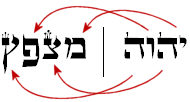
3. Gematria - A type of numerological
study that may be defined as one of more systems for calculating the
numerical equivalence of letters, words, and phrases in a particular Hebrew
text. These systems are used for the purpose of gaining insight into
interrelating concepts and for finding correspondences between words and
concepts. Using this method, the supposed angel Metatron was thought to be
particularly powerful because numerically this name is equivalent to
Shaddai.
4. Kabbalah - The kabbalah of
Names usually involves some permutation of the Sacred Name (YHVH) or the
association of the Ten Sefirot of the “Tree of Life” with certain
attributes of God.
|
|
|
|
|
|
Mystical Hebrew Names of
God
|
|
|
|
|
|
Monogrammata
|
|
|
|
|
|
The letter Hey (  ) commonly appears on Western European amulets (i.e., charms
or talisman), either alone or repeated five times to represent the Name of
God. ) commonly appears on Western European amulets (i.e., charms
or talisman), either alone or repeated five times to represent the Name of
God.
|
|
|
|
|
|

|
|
|
|
|
|
According to the Jewish
mystics, Hey represents the divine breath or revelation. On the fifth day,
the LORD created Light, and this corresponds to the letter Hey. Since the
numerical value of Hey is five, this corresponds on a physical level to the
five fingers, the five senses, and the five dimensions. On a spiritual
level it corresponds to the five levels of soul:
|
|
|
|
|
|
- Nefesh - instincts
- Ruach - emotions
- Neshamah - mind
- Chayah - bridge to transcendence
- Yechidah - oneness
|
|
|
|
|
|
“By the word of the
LORD were the heavens made; and all the host of them by the breath of his
mouth” (Psalm 33:6). In the Talmud (Menachot 29b) it is said that
the “breath of His mouth” refers to the sound of the letter Hey - the
outbreathing of Spirit.
|
|
|
|
|
|

|
|
|
|
|
|
The letter Aleph is the “father” of the Aleph-Bet,
whose original pictograph represents an ox, strength,
and leader. It’s numerical value is one (and also 1,000) and it is a silent
letter. Aleph therefore is preeminent in its order and alludes to the
ineffable mysteries of the oneness of God. Indeed, the word aluph (derived
from the very name of this letter) means “Master” or “Lord.”
In the classical Hebrew script (ketav Ashurit) used for writing
Torah scrolls, Aleph is constructed with two Yods (one to the upper right
and the other to the lower left) that are joined by a diagonal Vav. Ketav
Ashurit was the script that Jesus would have read (ketav Ivri was an
older script, similar to ancient Phoenician, but was not the script used
when Moses received the Torah from the LORD on Sinai. Ketav Ivri is also
sometimes called the Temple Script because samples of it are extant dated
to the time of Solomon’s Temple).
The basic gematria for the letter Aleph is one, indicating the One and only
God who is the Master of the universe. Note, however, that the gematria for
the parts of the letter Aleph add up to 26 (Yod+Yod+Vav). This is the same
number as the sacred Name YHVH, also indicating a link between the Aleph
and God Himself. This is also demonstrated in Exodus 3:14-15, where the
LORD reveals His Name (I AM THAT I AM)  to Moses. to Moses.

|
|
|
|
|
Digrammata
|
|
|

|

|
|
|
“Digrammaton” means
“two letters” and refers to a two-letter Name of God. In the Scriptures,
there are two main digrammata:

The Name  (Aleph-Lamed) comes from a root word meaning “might, strength,
power” and probably derives from the Ugaritic term for god. In Scripture,
the primary meanings of this root are “god” (pagan or false gods), “God”
(the true God of Israel), and sometimes “the mighty” (referring to men or
angels). When used of the true God of Israel, El is almost always
qualified by additional words that further define the meaning that
distinguish Him from false gods. These other Names or Titles for God are
sometimes called “construct forms.” (Aleph-Lamed) comes from a root word meaning “might, strength,
power” and probably derives from the Ugaritic term for god. In Scripture,
the primary meanings of this root are “god” (pagan or false gods), “God”
(the true God of Israel), and sometimes “the mighty” (referring to men or
angels). When used of the true God of Israel, El is almost always
qualified by additional words that further define the meaning that
distinguish Him from false gods. These other Names or Titles for God are
sometimes called “construct forms.”
Another digrammaton is the Name  (yah). It is generally thought that Yah is a shortened
form of YHVH. This Name of God occurs about 50 times in the Tanakh. In
Psalm 68:4 [5, H] this Name is particularly stressed. The Name YAH is also
found in the construct word “hallelu-YAH,” which means “you [pl.] praise
the LORD,” as well as in many Biblical proper names (e.g., Eliyahu). (yah). It is generally thought that Yah is a shortened
form of YHVH. This Name of God occurs about 50 times in the Tanakh. In
Psalm 68:4 [5, H] this Name is particularly stressed. The Name YAH is also
found in the construct word “hallelu-YAH,” which means “you [pl.] praise
the LORD,” as well as in many Biblical proper names (e.g., Eliyahu).
The Talmud states that God used the letter Hey to create the present world (olam
hazeh) and Yod to create the world to come (olam habah). The
sages derive this idea from the Name  (yah) found in Isaiah 26:4: (yah) found in Isaiah 26:4:

How did they come up with this? Well, they consider b’yah in
the text as meaning “with Yod-Hey” instead of referring to the Name
Yah.
In most Siddurim (prayerbooks) and other Jewish religious
literature, you will often see the Sacred Name written in an
abbreviated manner as Yod-Yod:

This is done to avoid casually reading, writing or saying the sacred Name
of God. Some mystics claim that this convention is also a Name of God,
though that is unlikely.
|
|

|

|
|
|
The
Tetragrammaton
|
|

|

|
|
|
In the Tanakh,
YHVH is the personal name of God and his
most frequent designation, occurring over 5,200 times. This is the
Ineffable Name or Unutterable Name of the God of Israel. Because it is
composed from the four Hebrew letters Yod, Hey, Vav, and Hey, it is also
referred to as the “Tetragrammaton,” which simply means “the four letters.”
Kabbalists use the Name (and permutations of it) in their meditations.
|
|

|
|

|

|
|
|

|
|
|
|
|
|
Though we do not
know how to pronounce the sacred Name, we can be confident that the letters
 derive
from the Hebrew verb “to be” (hayah) and indicate God’s utter
transcendence as the Source and Ground of all being. For more information
about the Sacred name, click here. derive
from the Hebrew verb “to be” (hayah) and indicate God’s utter
transcendence as the Source and Ground of all being. For more information
about the Sacred name, click here.
|
|
|
|
|
The
Octagrammaton
|
|
|

|

|
|
|
“Octagrammaton”
means “eight letters” and refers to an eight-letter Name of God created by
interspersing the letters for Adonai with the letters for the Tetragrammaton:
|
|

|

|

|

|

|

|

|
|
|

|
|
|
|
|
|

|
|
|
|
|
The
Decagrammaton
|
|
|
|
|
|
The so-called
“Ten Letter Name of God” is derived from running together the names of
the first three Sefirot (divine emanations or
attributes of God which are said comprise the mystical "Tree of
Life"): Keter (Crown), Chokhmah (Wisdom), and Binah
(Understanding):
|
|
|
|
|
|

|
|
|
|
|
|
The Twelve
Letter Name of God
|
|
|
|
|

|

|
|
|
There are two forms
of this Name. The first form of the twelve letter Name is simply YHVH three
times: YHVH YHVH YHVH:
|
|

|

|

|

|

|

|

|

|

|

|

|

|

|

|

|

|

|

|

|
|
|

|
|
|
|
|
|
This comes from the
prayer liturgy: Adonai Melech, Adonai Malchah, Adonai Yimlokh L’Olam Va’ed
– “YHVH is King, YHVH was King, YHVH will be King forever and ever.”
A second form of the 12-letter Name consists of the initials of the twelve
tribes of Israel. These are recited in reverse order according to the
breastplate of the Urim and Thumim: Reuven, Shimeon, Levi, Yehudah,
Issachar, Zevulon, Dan, Naftali, Gad, Asher, Yosef, and Benyamin:
|
|
|
|
|
|

|
|
|
|
|
|
The Fourteen
Letter Name of God
|
|
|
|
|
|
The Fourteen Letter
Name was derived from the phrase Adonai Eloheinu Adonai from the
Shema, and was sometime written on the backs of mezuzot. The Name is formed
by the simple method of substitution known as At Bash:
|
|
|
|
|

|
|
|
|
|
|
The 22 Letter
Name of God
|
|
|
|
|
|
The 22 Letter Name
is sometimes considered part of the 72 Letter Name (see below) that
includes reference to the 12 tribes of Israel (considered as Jeshurun):
|
|
|
|
|

|
|
|
|
|
|
Avraham,
Yitzhak, and Yaakov, the tribes of Yeshurun
(i.e., the upright).
|
|
|
|
|
|
The 33 Letter
Name of God
|
|
|
|
|
|
This Name is derived
from the Torah and is comprised of nine Names of God run together: Adonai,
El, Eloah, Elohim, Shaddai, Tzeva’ot, Ehyeh, Yah, and YHVH:
|
|
|
|
|
|

|
|
|
|
|
|
The 42 Letter
Name of God
|
|
|
|
|
|
The 42-Letter Name
(like many of the others) has no known pronunciation, and perhaps was
derived from the 2nd-century prayer “Ana Bekoach.” It is mentioned in
the Talmud and many of the Jewish Sages have speculated about its
significance:
|
|
|
|
|
|

|
|
|
|
|
|
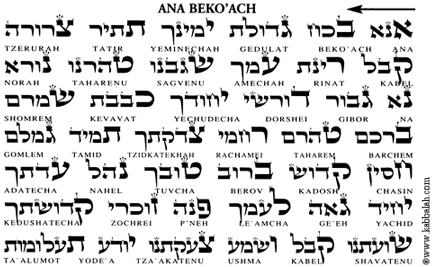
|
|
|
|
|
|
The 72 Names of
God - (or the 216 Letter Name of God)
|
|
|
|
|
|
The 216-Letter Name
of God is really a 72-part Name, since it is a sequence of 72 triads of
letters all of which are derived from permutations on Exodus 14:19-21
(which itself is composed of three verses of 72 letters each).
To create the first triad, you put together the first letter of verse
14:19, the last letter of verse 14:20, and then the first letter of 14:21.
To create the next triad, you put together the second letter of 14:19, the
second to last of 14:20, and the second letter of 14:21. This continues
until all the letters are used up. Like so:
|
|
|
|
|
|
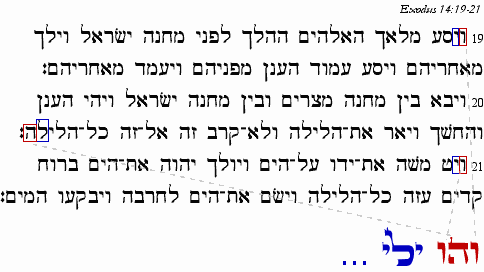
|
|
|
|
|
|
Using the
algorithm, you will find the following 72 triads of letters embedded in Exodus
14:19-21:
|
|
|
|
|
|
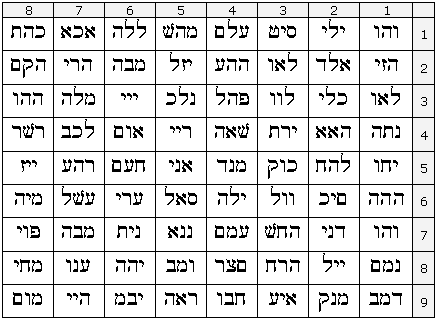
|
|
|

|

|
|
|
Theoretical Kabbalists
will look at each of the 72 triads and consider them as one of the 72
Names of God. They will perform various forms of gematria and other
analysis of these names in order to elicit spiritual insight and
transformation (this is sort of thing that Yehuda Berg does in his book, The
72 Names of God, Technology for the Soul).
Practical Kabbalists create amulets using the 216 Letter Name. The Name is
divided into two groups of thirty-six which the scribe writes on two amulets.
One amulet is worn on one arm and the other on the other arm.
|
|

|

|

|

|

|

|

|
|
|
The 304,805
Letter Name of God
|
|
|
|
|
|
What is the “best”
Hebrew Name of God? Some of the Jewish sages have said that it is revealed by
reciting all 304,805 letters of the Torah in a series. That is,
string together all 304,805 letters of the Torah - from the first letter of
Bereshit (Bet) through the last letter of Devarim (Lamed) -
and “read” this as a single “Word.” There you have it!

Obviously this “Name” of God is intended to humble us and to remind us that
God Himself is Ein Sof - without End or limitation of any kind. God
is always greater than our greatest thoughts about Him, even if we attempt
to express His transcendence by means of the sacred letters of the Torah.
Abba
Taking a different approach, we learn from the teachings of Yeshua the
Mashiach that the Name of God is best understood as “Father.” In fact,
Yeshua used the common Aramaic word for “daddy” (abba) to refer to
His relationship with God, and He wanted his talmidim (disciples) to
do likewise.
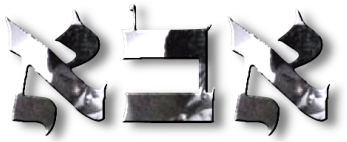
We do not need
gnostic awareness or ethereal speculations to help us understand the Name
of God our Father. He relates to us intimately as a good earthly
father relates to his children. We do not need incantations or abracadabra
to conjure up feelings to help us overcome the existential void that haunts
us - we can trust that the love of our Father in heaven as exemplified in
the gracious sacrifice of His Son for us. We do not trust in emanations of
spiritual forces hidden in Hebrew letters, since we can know the “Word that
is behind the word” as experienced in the life and love of Yeshua our
Savior.
It is well and good to understand the meaning of the hundreds of Names and
Titles of God as revealed in the Scriptures, of course, but in the end we
need to trust in Him as a small child trusts in the love of His daddy.
|
|
|
|
|
Hebrew for Christians
Copyright © John J. Parsons
All rights reserved.

|
|
|
|
|
|
|
|
|